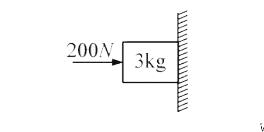In the arrangement shown in figure mA=4.kg and mB=1.0kg. The system is released from rest and block B is found to have a speed 0.3m/s after it has descended through a distance of 1.m find the coefficient of friction between the block and the table. Neglect friction elsewhere. (Take g=10m/s2).
 .
.
From constant relations, we can see that vA=2vB
Therefore, vA=2(0.3)=0.6ms−1
as vB=0.3ms−1 (given)
Applying Wnc=ΔU+ΔK
we get −μmAgSA=−mBgSB+12mAv2A+12mBv2B
Here SA=2SB=2m
as SB=1m (given)
∴−μ(4.0)(10)(2)=−(1)(10)(1)+12(4)(0.6)2+12(1)(0.3)2
or −80μ=−10+0.72+0.045
or 80μ=9.235 or μ=0.115
Topper's Solved these Questions
- BOOK - DC PANDEYCHAPTER - WORK, ENERGY AND POWEREXERCISE - CHECK POINT 6.120videos
WORK, ENERGY AND POWER
- BOOK - DC PANDEYCHAPTER - WORK, ENERGY AND POWEREXERCISE - CHECK POINT 6.220videos
WORK, ENERGY AND POWER
- BOOK - DC PANDEYCHAPTER - WORK, ENERGY & POWEREXERCISE - Level 2 Comprehension Based2videos
WORK, ENERGY & POWER
- BOOK - DC PANDEYCHAPTER - WORK, POWER AND ENERGYEXERCISE - E Integer Type Questions11videos
WORK, POWER AND ENERGY
Similar Questions
In the arrangement shown in figure mA = 4.0 kg and mB = 1.0 kg. The system is released from rest and block B is found to have a speed 0.3 m/s after it has descended through a distance of 1m. Find the coefficient of friction between the block and the table. Neglect friction elsewhere.
(Take g = 10 m/s2)
 View Solution
View SolutionConsider the situatioin shown in figure. The system is released from rest and the block of mass 1.0 kg is found to have a speed 0.3 m/s ater it has descended thrugh a distance of 1 m. find the coefficient of kinetic friction between the block and the table.
 View Solution
View Solution
Knowledge Check
- Question 1 - Select One
A block of mass 50 kg slides over a horizontal distance of 1m. If the coefficient of friction between their surface is 0.2, then work done against friction is (take g=9.8m/s2) :
A98 JB72 JC56 JD34 J - Question 2 - Select One
The blocks A and B shown in figure have masses MA=5kg and MB=4kg. The system is released from rest. The speed of B after A has travelled a distance 1m along the incline is
 A(a) √32√gB(b) √34√gC(c) √g2√3D(d) √g2
A(a) √32√gB(b) √34√gC(c) √g2√3D(d) √g2 - Question 3 - Select One

In the arrangement shown in the figure mAmB=23 and the ratio of density of block B and the liquid is 2:1 The system is released from rest. ThenAblock B will oscillate but not simple harmonicallyBblock B will oscillate simple harmonicallyCthe system will remain in equilibariumDNone of the above
In the given arrangement,the pulleys and strings are ideal.The blocks are released from rest and it is found that block A has speed 0.3ms after it has descended through a distance of 1m .The coefficient of friction (μ) is? (g=10ms2)
View SolutionA force of 200N is applied as shown in the figure on block of 3 kg. The coefficient of friction between the block and the wall is 0.3. Find the friction acting on the block. (in N) {Take g = 10 m/s2
 View Solution
View SolutionThe fricition coefficient between the table and block shown in fig. is 0.2 find the acceleration of the system (Take g=10m/s2)
 View Solution
View SolutionWhen the three blocks of masses M, 2M and 2M in the system are released from rest, they accelerate with a magnitude of 1 m/s2. What is the coefficient of kinetic friction between block on the table and the table top? (neglect the force of friction in the pulleys and take g =10 m/s2)
View SolutionIf coeffiecient of friction between the block of mass 2kg and table is 0.4 then out acceleration of the system and tension in the string. (g=10m/s2)
 View Solution
View Solution

